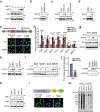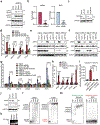R-loop-derived cytoplasmic RNA-DNA hybrids activate an immune response
- PMID: 36544021
- PMCID: PMC9949885
- DOI: 10.1038/s41586-022-05545-9
R-loop-derived cytoplasmic RNA-DNA hybrids activate an immune response
Erratum in
-
Author Correction: R-loop-derived cytoplasmic RNA-DNA hybrids activate an immune response.Nature. 2024 Feb;626(7998):E6. doi: 10.1038/s41586-024-07064-1. Nature. 2024. PMID: 38263519 No abstract available.
Abstract
R-loops are RNA-DNA-hybrid-containing nucleic acids with important cellular roles. Deregulation of R-loop dynamics can lead to DNA damage and genome instability1, which has been linked to the action of endonucleases such as XPG2-4. However, the mechanisms and cellular consequences of such processing have remained unclear. Here we identify a new population of RNA-DNA hybrids in the cytoplasm that are R-loop-processing products. When nuclear R-loops were perturbed by depleting the RNA-DNA helicase senataxin (SETX) or the breast cancer gene BRCA1 (refs. 5-7), we observed XPG- and XPF-dependent cytoplasmic hybrid formation. We identify their source as a subset of stable, overlapping nuclear hybrids with a specific nucleotide signature. Cytoplasmic hybrids bind to the pattern recognition receptors cGAS and TLR3 (ref. 8), activating IRF3 and inducing apoptosis. Excised hybrids and an R-loop-induced innate immune response were also observed in SETX-mutated cells from patients with ataxia oculomotor apraxia type 2 (ref. 9) and in BRCA1-mutated cancer cells10. These findings establish RNA-DNA hybrids as immunogenic species that aberrantly accumulate in the cytoplasm after R-loop processing, linking R-loop accumulation to cell death through the innate immune response. Aberrant R-loop processing and subsequent innate immune activation may contribute to many diseases, such as neurodegeneration and cancer.
© 2022. The Author(s), under exclusive licence to Springer Nature Limited.
Conflict of interest statement
Competing Interests
K.A.C. is a scientific advisory board member of RADD Pharmaceuticals. M.A-R. is a scientific advisory board member of Lycia Therapeutics. The other authors declare no competing interests.
Figures














References
-
- Santos-Pereira JM & Aguilera A R loops: new modulators of genome dynamics and function. Nat. Rev. Genet. 16, 583–597 (2015). - PubMed
REFERENCES FOR METHODS
Publication types
MeSH terms
Substances
Grants and funding
LinkOut - more resources
Full Text Sources
Molecular Biology Databases
Research Materials
Miscellaneous

